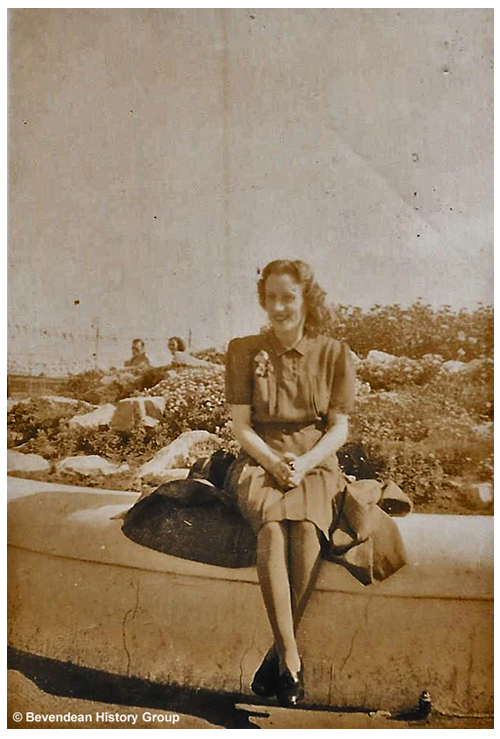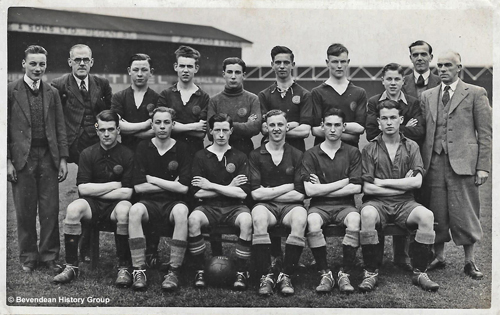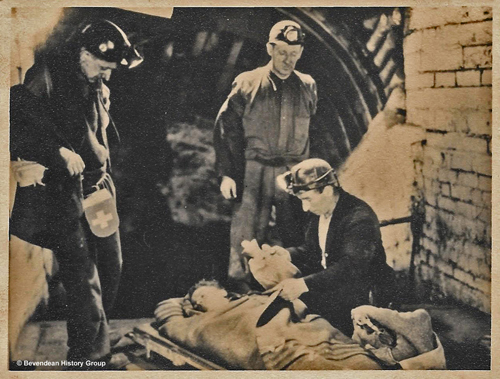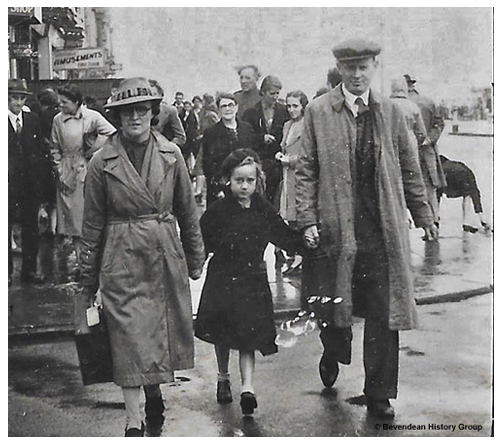
Peoples Stories - Bevendean History Project
Les Wilson memories of Bevendean - continued Wartime as a Bevin Boy
Wartime as a Bevin Boy
Les looked at a photograph of a party to celebrate victory Europe day
at the end of Lower Bevendean Avenue. That’s Bransby Jones in the
picture I don’t remember the party as I was away at the time. I
was home for the end of the war the victory in Japan. Bransby Jones was
the vicar of St Andrews church, he left in 1949.I came back in 1947 and he was still here. He was the one that got me in the colliery in Wales, as he used to be the vicar of that village. They say he came here in 1935. He went to Portslade first. In September 1934 they had the terrible mining disaster in Dennis (the main shaft) in Gresford Colliery North Wales and Bransby Jones was the vicar of Llay the next door village where I was sent. He was there then and he went to see some of the people of Llay whose relatives were killed in the disaster that was in September 1934. They’re still down there, all the men they never got them out and when I was up there and we were digging the coal we were digging towards the same Dennis shaft. I left before they got that far, they sunk the pit to a mile deep, I didn’t know that when I was working on the fourteens (coal face area) at the time that we were a mile underground.
 |
This photograph is of a singer, Iris Jenkins and she sang soprano in the
Messiah. I got to know her dad, he was seriously injured and they put him on the telephones. There were a lot of people who worked in the pit. |

A Football Team consisting of miners from Llay Colliery.
Sometime after I left Llay, Marion and I went up to see my mate who worked in the ambulance room and he was on duty on a Sunday. We saw the chappie; he said do you want to go down? But I said how do you get down and he said there are ways and means, but don’t say anything to anybody. They took Marion and me down. It was a double change then, because as we were going down to the bottom of number 1 pit which was still illuminated, they hadn’t closed it off, and I couldn’t believe it was a mile deep.
I’ve got a little bit of coal that Marion pulled off the coalface there, which is on the shelf. The colliery is gone now. It took 6,000 tons of slurry to fill up the 2 mineshafts. It’s all filled in they’ve got a ring of stones round there with a bit of a garden, that’s all that is left. There still a lot of good quality coal left under the ground. When I was there I talked to a lot of people and they said they were trying to burn it in situ to extract the gas, but they won’t get the heat from it, but I never heard any more about it. Whether it failed I don’t know, but there still a lot of coal there.

This photo was taken at the bottom of number 2 pit, it was a First Aid Exercise, and they gave me that photo.
Mrs Thatcher and Arthur Scargill got rid of the mines. Thatcher made 2 mistakes, they were because of her personality, one of them was that she sold the council houses, which she should not have done and the second thing was that she wasn’t a give-and-taker. When she came up against Scargill neither of them would give and in the end the whole lot went. The whole industry went, even the people who backed her up in the strike, those who worked during the strike they all went. I keep in touch with the people in Wales I am a godparent to one of them. You could refer to my memory in the book “A Far Cry From a White Apron”, I wrote will Michael.
I got my call up papers on Christmas Eve, although we used to have a post on Christmas Day, and they said I had got to go to Coventry to train and it was a right waste of time. Bransby Jones said to me before I left, see if you can get to Llay mine colliery so I can get you digs. I came home on the Saturday and I went down to see him on Sunday. He pulled out an old church magazine, tore the back page off and he wrote a letter and put it to Haynes the Post in Llay, he was a churchwarden, and he got me my digs. That’s how I got to go, I asked to go to Llay and they let me, but then they realised it wasn’t a good idea to let people go where they wanted to, so they stopped it and just put you in a colliery were you were needed. I was lucky, it was a mechanical colliery with no horses and so therefore there were no rats, no mice and no forage. There was only one wet spot and that didn’t matter, they had stalactites hanging down over a travelling road so it didn’t matter. It was quite a good thing, I was on the lash and that was it. There was a great road coming out, it went up and down, a mile long the thing was. We used to lash full wagons on with the chain at the bottom and at the top do the same with empty ones. I was lashing on wagons that held half a ton of coal which were going up an incline all the time. I always thought we were only ¾ mile down, we used to get hot down there, it got really hot in the summer we were stripped to the waist and I could drink 6 pints of water on a shift, and I could also knock back some pints at the end of the shift when I was out. The cage we went down in went down vertically in one drop.
In Ovingdean church on the second Wednesday of the month, we have a Songs of Praise where you choose hymns and then they ask you to talk about why you chose it. Once I chose the hymn “Guide Me O Thou Great Jehovah”, not Redeemer, but Jehovah. They used to sing that going to work but I couldn’t understand that, we only ever got 2 verses in because we were down the bottom of the shaft. And I said to them down there, I was a believer and if you can’t beat them join and I used to sing hymns going to work every day on my shift. The people I lived with were evangelical really, Protestant Evangelical Church, almost clap hands here comes Charlie.
Wilson Lloyd went to a church where they all spoke Welsh. Wilson Lloyd was my mate who I met in the pit, we paled up. He’s dead now he had a stroke or heart attack.

That’s Mr & Mrs Lewis on holiday; they are in the book “A Far Cry From A White Apron”. They were the people I lived with and that’s their daughter in the photo, they had another daughter afterwards and I was godfather to her.
It was almost living home from home they looked after me and I was treated as one of the family I went to the funerals, the marriages and all the dos that they had, they always invited me. That all came about from Moulsecoomb church, because Bransby Jones was the vicar there. Willie Oelsner was there as well, you wouldn’t remember him he was a German priest. He went to Hove afterwards, Holy Trinity North of George Street. That’s where he went, because when I organised a fellowship reunion he came to the first one, I was surprised. He was a nice enough chap he was something to do with the German chap who was against Hitler. My mum was dead against him, but he wasn’t bad, quite a nice chap really when you got to know him. He came up to see me when I was in hospital and that’s how I got to know him.
31st October 2014

Story_008b